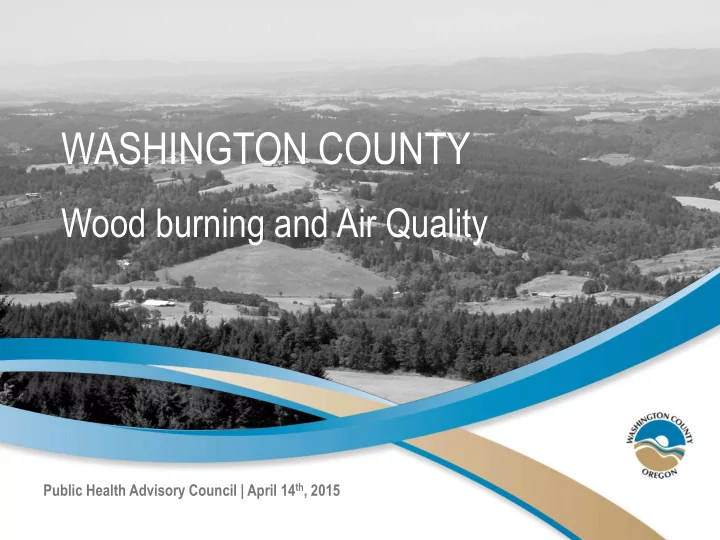

WASHINGTON COUNTY Wood burning and Air Quality Public Health Advisory Council | April 14 th , 2015
Agenda • Air Quality 101 • Particulate Matter 2.5 • PM 2.5 in Washington County • Work to date • Strategies moving forward • Discussion
Carbon Monoxide - Lead - Nitrogen Dioxide - Ozone - Particulates - Sulfur Dioxide Manganese Chromium Chlorobenzene Cobalt Chlorine Trimethylbenzene Beryllium Acetaldehyde Biphenyl Ethylbenzene Aniline Nitric Acid Arsenic CO2 Cadmium Formaldehyde Toluene Phthalates Benzene PAHs Nickel Acrolein Styrene Cyanide Dioxins
Particulate Matter 2.5 • Byproduct of combustion • Acts as a vehicle for heavy metals and other toxics • Health effects include: – premature death in people with heart or lung disease, – nonfatal heart attacks, – irregular heartbeat, – aggravated asthma, – decreased lung function, and – Upper respiratory symptoms • 1 ton of PM2.5 = $360,000 in morbidity and mortality
Air Quality Monitors Hare Field Monitor Highland Park Middle
Seasonal Peaks 2013 Hillsboro Air Quality Index Based on PM2.5 200 AQI Count 190 Good 281 180 Unhealthy Mod 71 170 UFSG 8 160 Unhealthy 1 150 Missing 4 Total 365 140 Unhealthy 130 For 120 Sensitive 110 Groups AQI 100 90 80 Moderate 70 60 50 40 30 Good 20 10 0 J F M A M J J A S O N D Month
Daily Patterns
Wood Smoke Patterns • Wood smoke is a major source of Particulate matter 2.5 in Washington County • Daily patterns point to residential wood burning • Annual levels are highest during cold- snaps in the winter
Unique Factors • Geography • Differences in policies and regulations • Varying levels of access • Intel permitting process
Geography
Inversions and Stagnation
Differences in Policy Burn Ban Boundary Source: Oregon Department of Environmental Quality
Source: Oregon Department of Environmental Quality
Varying Access to Alternatives
Intel Permitting Process • Facility expansion is triggering a permit renewal • Intel seeking to double emissions of PM 2.5 • If the permit is approved, Intel’s contribution will be less than 1% of community-wide contribution
2014-15 Winter Season Accomplishments: • Hired Senior Program Coordinator • Developed air quality communications plan • Daily air quality forecasting • Collaborating with various stakeholders (city governments, utility providers, hearth/stove retailers, existing programs in Oregon)
Essential Elements of a Successful Program • Community education and outreach – Burn less – Burn wise • Woodstove replacements and upgrades • Curtailing wood smoke – Voluntary programs – Mandatory programs
Education and Outreach • Critical to the successful implementation of every strategy • Air Quality Education and Outreach Advisory Team – Develop key messaging – Identify the best communication channels – Identify outreach opportunities
Wood Stove Replacement Program • Description: Incentivizing the removal and/or replacement of old and uncertified wood stoves • Advantages: Supports families who rely on wood heating • Disadvantages: replacing wood stoves alone is not sufficient to reduce levels, can be costly
Curtail Indoor Burning Policy options: – Voluntary • Forecasting the air quality • Alerting the community of poor air quality • Asking the community to burn less during “yellow” and “red” days – Mandatory • Forecasting the air quality • Alerting the community of poor air quality • Asking the community to burn less during “yellow” days • Prohibit burning on “red” days (exceptions for low-income and sole-source)
Curtail Outdoor Burning • Often called “backyard burning”, refers to the burning of some household waste and yard debris. • Accounts for 8% of annual PM 2.5 emissions. • Inconsistent regulations: • Policy questions: – Should we regulate the unincorporated areas? – Should the County enforce the state metro-area burn ban – Should incorporated cities follow King City?
Discussion Questions • How do we best talk with the community about this issue? • What is your general impression of the essential elements ( education, policy and wood stove change outs )? • How do we balance individual rights and community health? • What opportunities do you see to mobilize the community? • What concerns do you have?
Recommend
More recommend